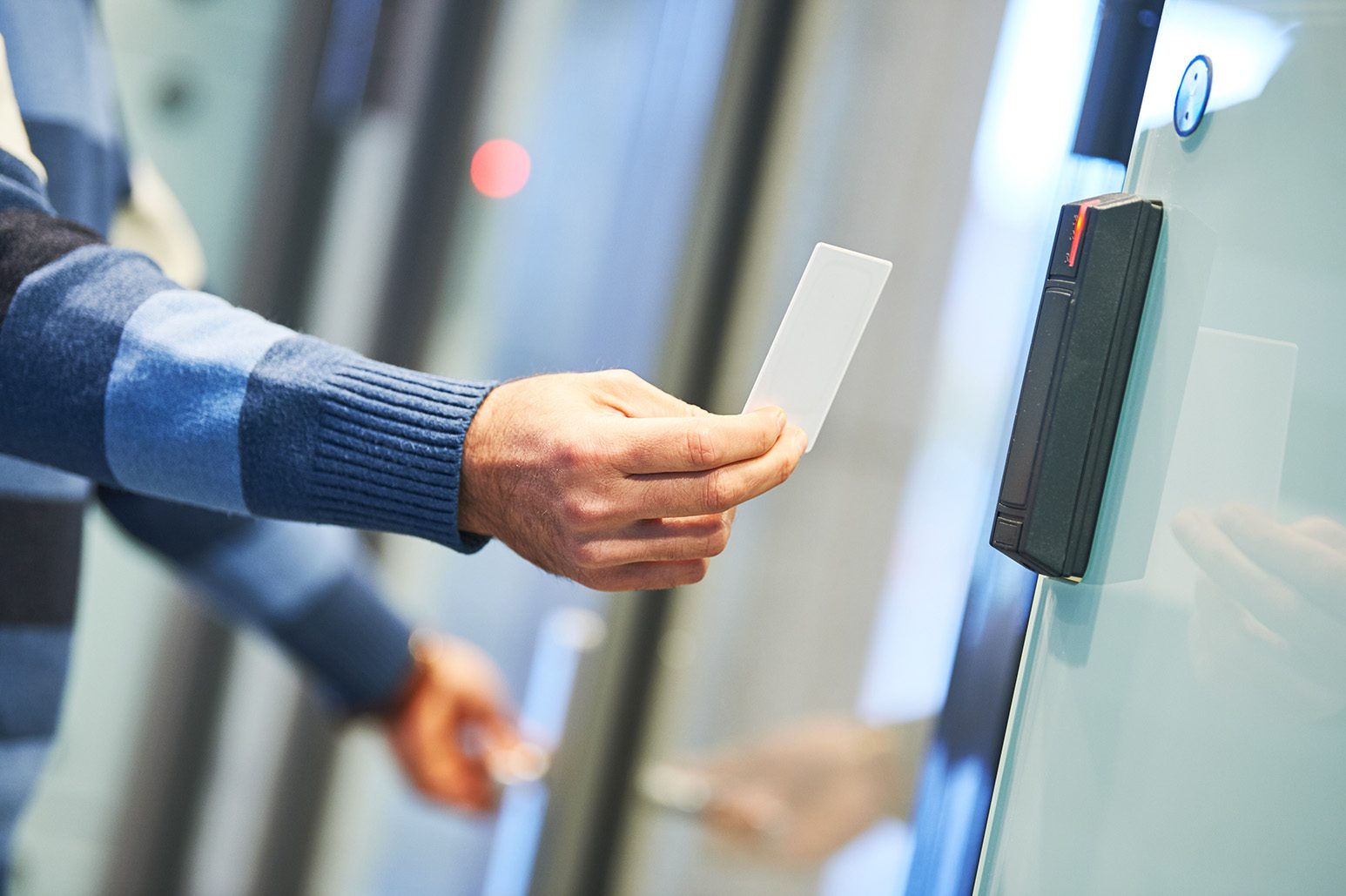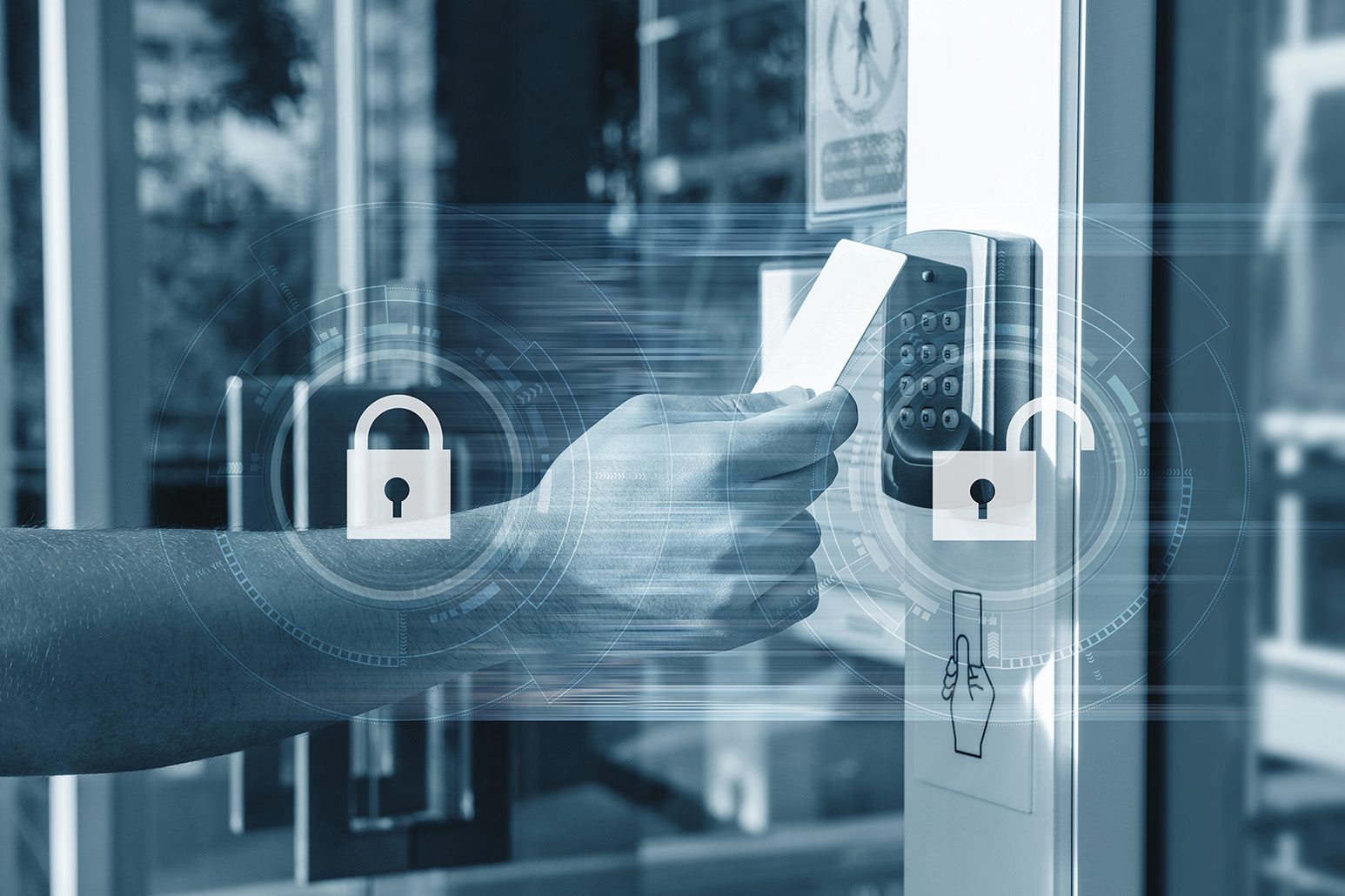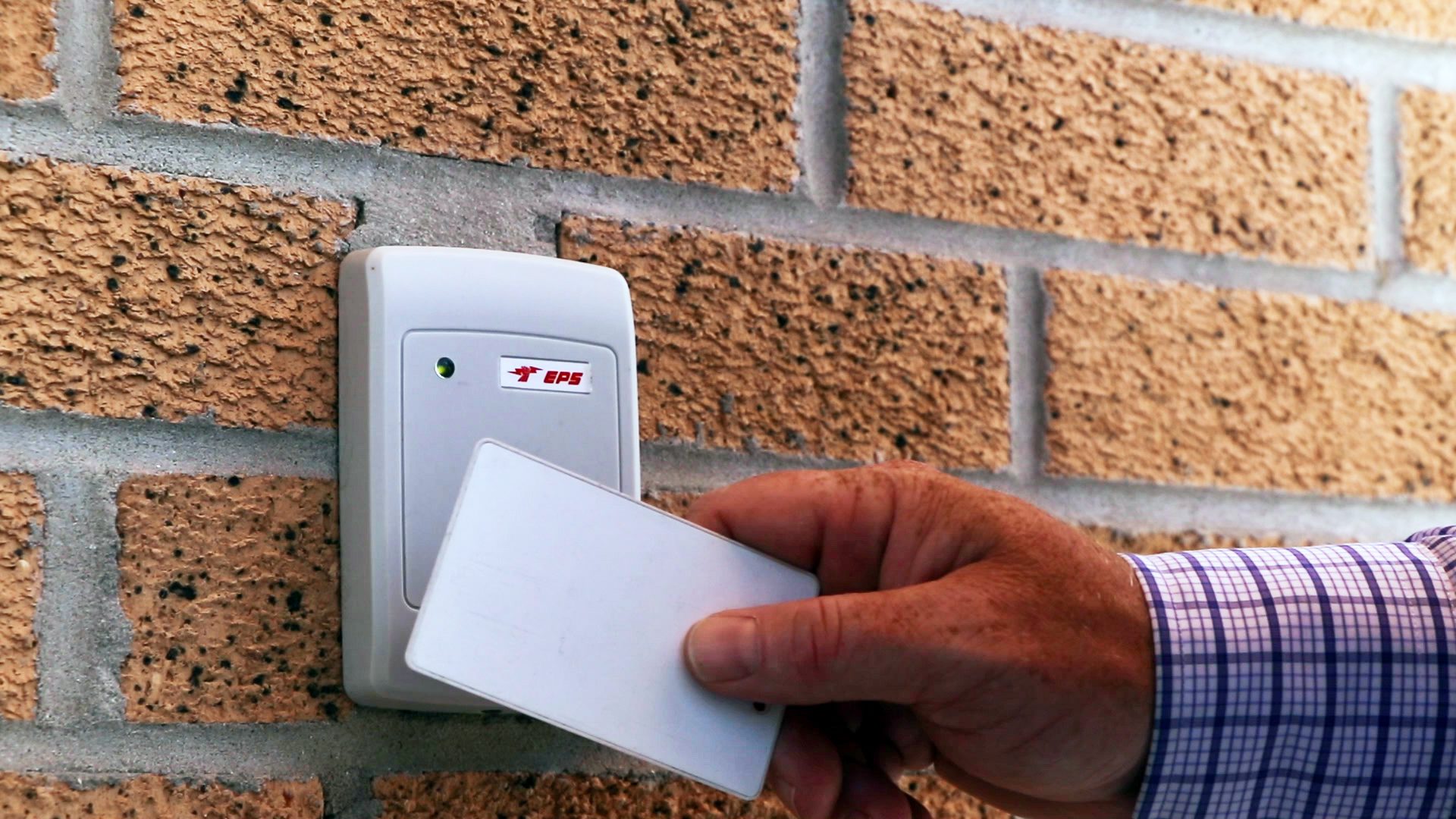
Humanity has tried to control who comes through their doors since the first straw hut was thatched together millennia ago. While initial efforts to control the flow of traffic focused on keeping the elements and wild animals at bay, over the course of time focus expanded to include barring strangers and ill-intentioned persons from gaining access to private food stores, belongings, and the family unit as a whole.
For the most part, humanity has succeeded at keeping grizzly bears out of their foyers, but doors shoulder a heavier burden than ever as they are expected to perform more complex tasks. In the modern world, businesses especially have evolved past traditional lock-and-key options in favor of card access solutions, a door security technology that has revolutionized the way businesses handle who has access to their buildings and when. While doors have been around since the dawn of civilization, card access solutions aren’t even a hundred years old—and there’s reason to believe we’ve only scratched the surface of door security technology capabilities.
 The first “access control” device: the door lock
The first “access control” device: the door lock
For many thousands of years, door locks were the only means of preventing people from entering/exiting a room or building outside of barricading a door shut. Archaeologists have discovered primitive locks that are 6,000 years old in various parts of the ancient world, eventually morphing from wooden apparatuses such as the Egyptian wooden pin lock into the metal lock-and-key design more familiar to modern eyes. Despite the handcrafting required to make each lock , the relative simplicity of these early contraptions made them “pickable” to professional thieves. Despite these limitations, the basic “lock-and-key” concept—where a physical key is required to gain access to a locked space—formed the basis of door security that exists to this day.
It wasn’t until the late 1700s that locks and keys evolved past a basic pins-and-bolts design—thanks in large part to the technological advancements of the Industrial Revolution. The lever-tumbler lock, invented by Robert Barron in 1778, forewent pins entirely in his design, instead opting to have the key lift a lever to release the locking bolt. As the internal mechanisms of locks grew more advanced, so did keys, the heads and blades eventually taking the shape to which we are currently accustomed. The common Yale lock took the ancient Egyptian pin lock idea and brought it into the modern age by Linus Yale Sr. in 1848, its newest iteration coined the “pin-tumbler lock.”
With the ability to mass-produce and standardize products at unprecedented levels, the Industrial Revolution brought door security to the masses in an affordable way. Even though many of these innovations came over two centuries ago, conventional “locks and key” door security remains fundamentally the same, utilizing the basic level-tumbler and pin-tumbler concepts from the days of yore.
Of course, mass-production and standardization come at a price. The proliferation of locks gave rise to a widespread interest in lockpicking by burglars and thieves. Additionally, the ability to duplicate physical keys made it easier for the keys of former home owners or ex-employees to wind up in the hands of those who had no business holding them. The basic “lock and key” concept created entirely new sets of problems:
- What if I misplace my keys?
- What if an employee makes copies of my key without my knowledge?
- What if I lock my keys inside?
- What if I forget to lock the doors at night?
For thousands of years, people were forced to accept that locked doors contained both serious security vulnerabilities and the inability to differentiate desired visitors from unwanted ones—that is, until the invention of access control/key card systems.
 Safer, smarter door security
Safer, smarter door security
It wasn’t until later in the 20th century that door security began to resemble the advanced systems we are accustomed to now. In the 1970s, hotels began favoring “punch card” technology over conventional “lock and key” methods to improve both guest and staff experience. These punch cards required a cardholder to slide a unique card with raised bumps or holes into a “reader, which released the locking mechanism in a method similar to a pin-tumbler lock. These “punch cards” reached the peak of their popularity in the 1970s, especially once Norwegian engineer Tor Sørnes invented a card that could be re-coded instead of thrown away after each use. By the 1980s, however, punch cards had already become obsolete and replaced by electrified “magstripe” cards. The first magnetic-striped cards were invented in the 1960s and were initially made for data storage purposes (think debit and credit cards) before their use as a unique “key” in a door security system was fully realized. Magstripe cards were easy to activate or turn off and comparatively cheap to purchase (or replace). However, magstripe cards carried the same security vulnerabilities that eventually plagued credit cards. All magstripe cards eventually demagnetize. Also, based on how they are configured, magstripe card readers can be manipulated by informed hackers to gain access—a major concern for operations with high-value or sensitive inventory.
Two major inventions helped revolutionize card access systems into what they are today. Firstly, the internet transformed the world in the 1990s, allowing for server-based databasing and networking. Secondly, Radio Frequency Identification (RFID) was created in part to overcome the demagnetization issues with magstripe cards. In RFID door security systems, unique identification data is programmed to a card (the “key”), and the card shares that data when it is near a card reader via electromagnetic waves. Depending on the design and device, RFID readers can pick up a card or fob from several inches to several feet away. The data is then run through the card access database, and if that card has been programmed to access that specific door, the magnetic lock disengages, granting access to the cardholder. By doing so, access control systems allow for the differentiation between those who are allowed in a certain area and those who are not. This entire process can happen in a fraction of a second!
 The RFID card access system is the most commonly used door security solution in modern businesses. The ability to reference a central database allows for layers of security unavailable to lock-and-key or even magnetic stripe card systems. In an instant, card scans can be run against the database to determine whether X user should be allowed in Y door at Z time—and, if not, the access request can be denied. Such programs can even be instructed to only allow cards to scan in if there is a corresponding scan out, which prevents someone from entering, walking out the door, and passing the card off to someone else. These databases can even be used for multiple sites, allowing access to a single person at one building, several buildings, or all buildings across multiple locations or a single sprawling campus.
The RFID card access system is the most commonly used door security solution in modern businesses. The ability to reference a central database allows for layers of security unavailable to lock-and-key or even magnetic stripe card systems. In an instant, card scans can be run against the database to determine whether X user should be allowed in Y door at Z time—and, if not, the access request can be denied. Such programs can even be instructed to only allow cards to scan in if there is a corresponding scan out, which prevents someone from entering, walking out the door, and passing the card off to someone else. These databases can even be used for multiple sites, allowing access to a single person at one building, several buildings, or all buildings across multiple locations or a single sprawling campus.
Card reading technologies have advanced to the degree where high-tech door readers can act as their own control panel instead of relying on a connected master controller. These super-powerful devices, called IP door readers, utilize internet connectivity to run cards against an individually-programmed database. First appearing in 1999, the chief detriment of these “all-in-one” readers is that they are completely internet reliant and thus subject to internet-related issues such as network failures and heavy traffic. Whether these readers “take off” in the same manner as their RFID counterparts has yet to be determined, but in the age of “smart” devices, it is entirely possible that stronger, better internet capabilities for businesses may provide IP readers with the necessary juice to operate at high levels.
 Card access…without the cards?
Card access…without the cards?
Even with RFID, magnetic locking, and internet technologies, door security has existed under the same dichotomy for 6,000 years: you need a key to open a lock. Even new Bluetooth access technology uses a smartphone as the aforementioned lock, requiring visitors to carry some item on their person which will grant them access to a locked door. In the future, though, keys may be a thing of the past—and that future is dawning now with advances in biometrics.
With a biometric security device, the user doesn’t carry a physical key. Instead, the visitor becomes the key as an electronic biometric device scans one of the several physical traits that differentiate one human being from another and runs it against the existing database. The concept that humans have physical identifiers that are completely unique to each individual isn’t new—fingerprinting dates all the way back to 1892!—but the idea wasn’t applied to physical security until the 1980s when the first “hand geometry” scanner began appearing commercially. Hand geometry scanners are named after how they function—they capture an image of the hand, compare it to “accepted” hands stored in a database, and either allow or deny access based on the results of the comparison. The original scanners would be considered basic by today’s standards and could be fooled with “similar-enough” hand shapes, but the geometry scanners of today are far more precise and thus immensely more reliable.
Iris scanners have entered the popular conscience through movies such as “Mission Impossible,” but the origins of the technology stretch all the way back to the 1980s. At this time, several scientists and doctors had proposed that irises could be used as unique biometric identifiers, but it wasn’t until John Daugman developed an algorithm for practical use that iris recognition could be applied commercially starting in the 1990s. Iris scanners are more precise than hand geometry scanners, but they contain unique pitfalls unto themselves. Many scanners can be fooled by a high-quality image of an “accepted” eye or face, which makes beating the system far-fetched but entirely possible. Also, higher-security devices are prohibitively expensive for the average company. Biometric scanners in general are often not rated for outdoor use, limiting their efficacy at protecting perimeter doors.
Biometric technology shows promise in allowing for true “keyless entry,” but given their security vulnerabilities, for now they are most often used as an additional layer of door security. Companies will place a hand or iris scanner at a locked door which also requires a physical key or RFID card to add extra complications for unwanted malfeasants. And with advances in fingerprint scanning and both voice and facial recognition, it’s entirely likely that new biometric technologies will dominate the door security conversation for decades to come.
 Securing your business with EPS Security
Securing your business with EPS Security
Controlling the flow of traffic into and around your business is crucial to protecting your employees, inventory, and property. EPS Security was founded in 1955, which means we’ve kept pace with every major advancement in card access security since the theory was put into practice. We work with world leaders in access control technology to provide our customers with the protection they need to secure their facilities. We have decades of experience in engineering, installing, and maintaining card access systems as well as administrating access databases. Whether you have three or thirty doors that require attention, our team has you covered—and we’ll work with you to make sure your system is functioning as well on Day 1000 as it did on Day 1.
Don’t rely on 6,000-year-old technology to secure your business. Let EPS Security take you into the future with a card access system designed just for you.

